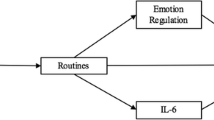Abstract
This study examined: (1) the relationship of familial factors to Latina adolescents’ depressive symptomology and, (2) the mediating role of parental connectedness in the relationships between perceived parental caring, academic interest and depression. The sample consisted of 276 Latina adolescents taken from the National Longitudinal Study of Adolescent Health (Add Health). A path model was hypothesized to illustrate the direct and indirect relationships between adolescent perceived mother connectedness, father connectedness, parental caring, parental academic interest, and depression. The hypothesized path model had good model fit: χ 2 (3, 224) = 6.53, p = .08; χ 2/df = 2.18; CFI = .99; TLI = .98; and RMSEA = .07. In addition, father connectedness was found to mediate the relationship between general caring and depression as well as academic interest and depressive symptoms. Mother connectedness mediated the relationship between general caring and depressive symptoms. Consideration of Latina adolescents’ perceived parent–child relationship is of particular salience when working with depressed Latinas. Findings will be discussed for intervention and prevention efforts for Latina teens.




Similar content being viewed by others
References
Ackard, D. M., Neumark-Sztainer, D., Story, M., & Perry, C. (2006). Parent–child connectedness and behavioral and emotional health among adolescents. American Journal of Preventive Medicine, 30(1), 59–66. doi:10.1016/j.amepre.2005.09.013.
Buerkel-Rothfuss, N. L., Fink, D. S., & Buerkel, R. A. (1995). Communication in father–child dyad. In T. S. Socha & G. H. Stamp (Eds.), Parents, children, and communication: Frontiers of theory and research (pp. 63–86). Mahwah, NJ: Lawrence Erlbaum.
Castillo, L. G., Perez, F. V., Castillo, R., & Ghosheh, M. R. (2010). Construction and initial validation of the Marianismo Beliefs Scale. Counseling Psychology Quarterly, 23, 163–175. doi:10.1080/09515071003776036.
Céspedes, Y. M., & Huey, S. J. (2008). Depression in Latino adolescents: A cultural discrepancy perspective. Cultural Diversity and Ethnic Minority Psychology, 14, 168–172. doi:10.1037/1099-9809.14.2.168.
Chance, S. E., Kaslow, N. J., Summerville, M. B., & Wood, K. (1998). Suicidal behavior in African American individuals: Current status and future directions. Cultural Diversity and Mental Health, 4(1), 19. doi:10.1037/1099-9809.4.1.19.
Garcia, C., Skay, C., Sieving, R., Naughton, S., & Bearinger, L. H. (2008). Family and racial factors associated with suicide and emotional distress among Latino students. Journal of School Health, 78(9), 487–495. doi:10.1111/j.1746-1561.2008.00334.x.
Gulbas, L. E., Zayas, L. H., Nolle, A. P., Hausmann-Stabile, C., Kuhlberg, J. A., Baumann, A. A., & Peña, J. B. (2011). Family relationships and Latina teen suicide attempts: Reciprocity, asymmetry, and attachment. Families in Society: The Journal of Contemporary Social Services, 92(3), 317–323. doi:10.1606/1044-3894.4131.
Hu, L., & Bentler, P. M. (1999). Cut off criteria for fit indexes in covariance structure analysis: Conventional criteria versus new alternatives. Structural Equation Modeling: A Multidisciplinary Journal, 6, 1–55. doi:10.1080/10705519909540118.
Kline, R. B. (2005). Principles and practice of structural equation modeling (2nd ed.). New York: Guilford Press.
Kobus, K., & Reyes, O. (2000). A descriptive study of urban Mexican American adolescents’ perceived stress and coping. Hispanic Journal of Behavioral Sciences, 22(2), 163–178. doi:10.1177/0739986300222002.
Loehlin, J. C. (1998). Latent variables models: An introduction to factor, path, and structural analysis (3rd ed.). Mahwah, NJ: Lawrence Eribaum Associates.
Mombourquette, C. A. (2007). A study of the relationship between the type of parental involvement and high school student engagement, academic achievement, attendance, and attitude toward school. Dissertation Abstract International, 68(3). (UMI No. AAT 3258724) Retrieved August 11, 2011, from Dissertations and Theses database.
Piña-Watson, B., Castillo, L. G., Jung, E., Ojeda, L., & Castillo-Reyes, R. (2014). The Marianismo Beliefs Scale: Validation with Mexican American Adolescent Girls and Boys. Journal of Latina/o Psychology, 2(2), 113–130.
Piña-Watson, B., Castillo, L. G., Ojeda, L., & Rodriguez, K. M. (2013). Parent conflict as a mediator between marianismo beliefs and depressive symptoms for Mexican American college women. Journal of American College Health, 61(8), 491–496.
Punyanunt-Carter, N. M. (2008). Father–daughter relationships: Examining family communication patterns and interpersonal communication satisfaction. Communication Research Reports, 25, 23–33. doi:10.1080/08824090701831750.
Radloff, L. S. (1977). The CES-D scale: A self-report depression scale for research in the general population. Applied Psychological Measurement, 1, 385–401. doi:10.1177/014662167700100306.
Rastogi, M., & Wampler, K. S. (1999). Adult daughters’ perceptions of the mother–daughter relationship: A cross-cultural comparison. Family Relations, 48, 327–336. doi:10.2307/585643.
Resnick, M. (2000). Protective factors, resiliency, and healthy youth development. Adolescent Medicine, 11, 157–164.
Rew, L., Thomas, N., Horner, S. D., Resnick, M. D., & Beuhring, T. (2001). Correlates of recent suicide attempts in a triethnic group of adolescents. Journal of Nursing Scholarship, 33(4), 361–367. doi:10.1111/j.1547-5069.2001.00361.x.
Santiago-Rivera, A. L. (2003). Latinos, value, and family transitions: Practical considerations for counseling. Journal of Counseling and Human Development, 35, 1–12.
Turner, S. G., Kaplan, C. P., Zayas, L., & Ross, R. E. (2002). Suicide attempts by adolescent Latinas: An exploratory study of individual and family correlates. Child and Adolescent Social Work Journal, 19(5), 357–374. doi:10.1023/A:1020270430436.
Weston, R., & Gore, P. A. (2006). A brief guide to structural equation modeling. The Counseling Psychologist, 34(5), 719–751. doi:10.1177/0011000006286345.
Youniss, J., & Ketterlinus, R. D. (1987). Communication and connectedness in mother- and father-adolescent relationships. Journal of Youth and Adolescence, 16, 263–280. doi:10.1007/BF02139094.
Zayas, L. H., Bright, C., Alvarez-Sanchez, T., & Cabassa, L. J. (2009). Acculturation, familism and mother–daughter relations among suicidal and non-suicidal adolescent Latinas. Journal of Primary Prevention, 30, 351–369. doi:10.1007/s10935-009-0181-0.
Zayas, L. H., Kaplan, C., Turner, S., Romano, K., & Gonzalez-Ramos, G. (2000). Understanding suicide attempts by adolescent Hispanic females. Social Work, 45, 53–63. doi:10.1093/sw/45.1.53.
Zayas, L. H., Lester, R. L., Cabassa, L. J., & Fortuna, L. R. (2005). Why do so many Latina teens attempt suicide? A conceptual model for research. American Journal of Orthopsychiatry, 75, 275–287. doi:10.1037/0002-9432.75.2.275.
Author information
Authors and Affiliations
Corresponding author
Rights and permissions
About this article
Cite this article
Piña-Watson, B., Castillo, L.G. The Role of the Perceived Parent–Child Relationship on Latina Adolescent Depression. Child Adolesc Soc Work J 32, 309–315 (2015). https://doi.org/10.1007/s10560-014-0374-0
Published:
Issue Date:
DOI: https://doi.org/10.1007/s10560-014-0374-0




